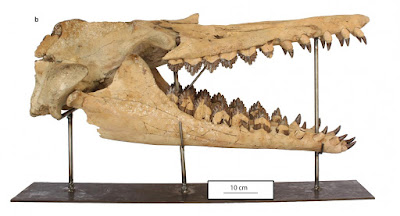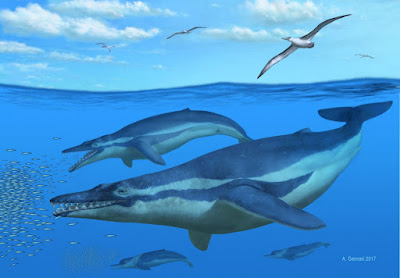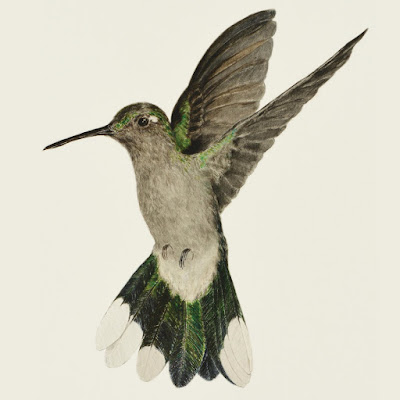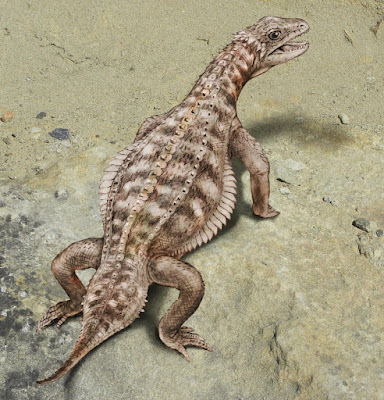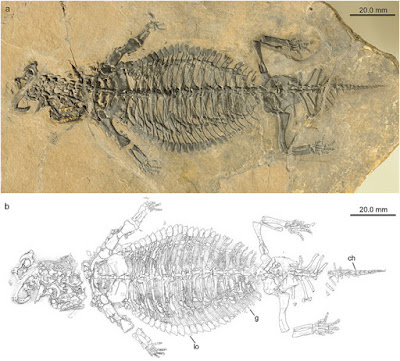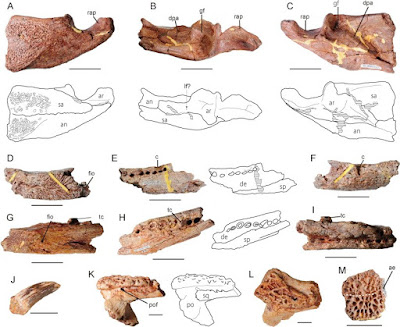![]() |
Eekaulostomus cuevasae
Cantalice & Alvarado-Ortega, 2016 |
ABSTRACT
Eekaulostomus cuevasae gen. and sp. nov. is described and identified here as a new member of the superfamily Aulostomoidea. The single specimen known of this species is part of a newly fossil assemblage collected in the marine sediments belonging to the early Paleocene Tenejapa-Lacandón geological unit, exploited in the Belisario Domínguez quarry, near Palenque town, State of Chiapas, southeastern Mexico. E. cuevasae represents the oldest aulostomoid as far known and the first fossil species of this superfamily collected in America. E. cuevasae differs from other aulostomoids in the presence of two spines preceding the soft rays of both dorsal and anal fins; the star-like scales covering the entire body and part of the snout; as well as the relative large number of principal rays in the caudal fin. The recognition of E. cuevasae as the stem group of Aulostomoidea increases the temporal and geographic distribution of this superfamily up to Danian and within the Caribbean region, when a large part of Chiapas was under the sea after the Cretaceous-Tertiary mass extinction event. This finding also provides evidences suggesting the membership of Aulostomoidea within the order Gasterosteiformes, in which the scutes covering the trunk and the robust spines in unpaired fins are recurrent features.
Keywords: new species; Aulostomoidea; fossil; Paleocene; Chiapas; Mexico
![]() |
| Figure 2: Holotype. IGM 4716, almost complete specimen exposing the right lateral side of the body. |
Superfamily AULOSTOMOIDEAsensu Greenwood et al., 1966
Family EEKAULOSTOMIDAE fam. nov.
Genus EEKAULOSTOMUSgen. nov.
Type species. Eekaulostomus cuevasae sp. nov.,
Derivation of name. The genus name includes the Mayan word “Eek” (= star), the Greek word "aulos" (= αὐλός, that is the name of an ancient flute), and the Latin word "stoma" (= mouth). The name refers to a "fish with a star-like scutes and flute-shaped mouth."
Eekaulostomus cuevasae sp. nov.
Derivation of name. The specific epithet of this fish honors our colleague, Martha Cuevas García, whose dedication and newly passion for the fossils led us to find the only specimen of Eekaulostomus cuevasae.
Occurrence. Paleocene (Danian, ≈ 63Ma) marine strata of the Tenejapa-Lacandón geological unit. Belisario Domínguez quarry, Salto de Agua Municipality, State of Chiapas, southeastern Mexico (Alvarado-Ortega et al., 2015).
Diagnosis. Aulostomoidea fish with rigid star-like scutes covering the whole trunk and part of the snout; pelvic fin placed anteriorly, just behind the postcleithrum; two spines in front of the soft rays of dorsal and anal fins; eight soft rays in both anal and dorsal fins; caudal fin formula iv+I+7—5+I+iii.
Fossils referring to the superfamily Aulostomoidea had been collected more than 200 years ago in Eocene and younger marine deposits along Europe. Although the extant aulostomoids form part of large modern cladistics essays, some are based on morphological evidences and others on molecular data; unfortunately, the fossil aulostomoids have never been phylogenetically studied. This situation has prevented the generation of a robust classification of the aulostomoids, and at the same time, has fueled the differences and contradictions between the phylogenetic hypotheses already published. It is so, that it is desirable to make these European fossils part of future cladistic studies; however, first we have to fulfill the task of re-describing them accurately using modern and homogeneous criteria. Only up to the present day, the distribution of fossil aulostomoids was restricted to Europe. Although this fact has not interested paleontologists outside of Europe to further collaborate in studies concerning the diversity evolution of aulostomoids; the goal of this paper is to provide the first tangible evidence that in the past, this fish group was also an inhabitant of the American seas.
From now on, we must take more seriously the paleontological surveys on late Cretaceous and early Paleocene sites with marine sediments present throughout the tropical region of America. As present study shows, fossils may exist that allow us to delve into the details of the evolution of the fishes on both sides of Cretaceous-Tertiary mass extinction event. Sadly, during the joint INAH-UNAM project, from which this article was drawn, no other fossil aulostomoid was recovered; however, the collection effort applied in Belisario Domínguez (where Eekaulostomus cuevasae gen. and sp. nov. came) as well as in its coeval and neighbor quarry, División del Norte, both with Danian marine sediments, really is far from reaching saturation.
The re-examination of the relationships of the Aulostomoidea executed here, using datasets previously generated by other authors and including Eekaulostomus cuevasae gen. and sp. nov., might not be the best way to achieve the desired understanding on the evolutionary processes of these fishes; however, this exercise significantly contributes to this goal. On the one side, the undeniable position of this new species as a primitive aulostomoid member, together with its deep morphological differences with other extinct and living taxa formally, or putatively, included in such superfamily, trace possible trends in morphological changes experienced by these fishes since the Paleocene to the present. This essay also widens the geographical scenario where the evolution of these fishes took place, extending from Europe to the tropical region of America.
Cantalice, Kleyton Magno and Alvarado-Ortega, Jesús. 2016. Eekaulostomus cuevasae gen. and sp. nov., An Ancient Armored Trumpetfish (Aulostomoidea) from Danian (Paleocene) Marine Deposits of Belisario Domínguez, Chiapas, southeastern Mexico. Palaeontologia Electronica. 19.3.53A: 1-24























